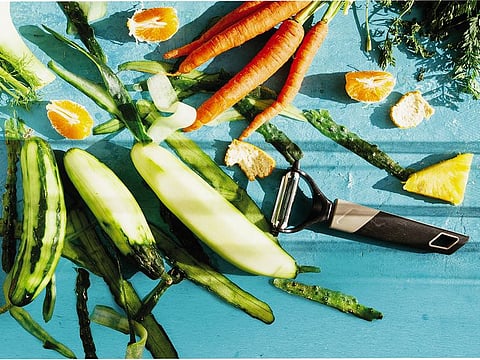Nutrition and food waste - what you need to know
Wasting less can improve your diet and slash your grocery bill and help the planet

How many times haven’t you heard that potato peels contain as much nourishment as the tubers themselves? If you’re the sort that mashes potatoes with their skins on, you can pat yourself on the back and skip straight past this introduction to find out where else you can mop up valuable dietary nutrients.
But anyone throwing away potato peels, broccoli stems and watermelon rinds is simply binning money. Approximately a third of all food produced in the world remains uneaten each year, going from farms to landfills via a circuitous route that involves farms, supermarkets and restaurant and consumer kitchens. The cost? An astounding $940 billion (Dh3.45 trillion). Or 8 per cent of all greenhouse gases, the World Resources Institute estimated in an August report.
Certainly, much of this is wasted by supermarkets who won’t display ugly fruit and vegetables because no one will buy it, or by distributors who don’t store perishable items properly. However, consumers are almost equally to blame, because we often simply throw out large quantities of leftovers or fresh produce that’s lost its perkiness.
But food waste is one global problem where each of us can make a visible impact. Not only will using every part of the meat and vegetables save you money, but as nutritionists explain, it can improve your diet, all while virtuously doing your bit for the planet.
“We need to be mindful on what we are tossing in the bin not only we can help our pockets but also help our environment,” explains Marlene Cornes Marsh, Senior Clinical Dietitian at Dubai Health Authority.
“Nutrition can literally be found in the waste we throw if we look closer and pay attention to it. A lot of waste items especially from fruits and vegetables scraps can be reused, regrown and recycled. We can make sauces, soup base stocks, and others to name a few uses.”
UAE initiative
At the Jumeirah Beach Hotel in Dubai this month, the United Nations World Food Programme (WFP) launched #StopTheWaste, a worldwide campaign aimed at raising awareness about the huge amounts of edible food that is discarded daily. Mariam Hareb Almheiri, Minister of State for Food Security, called on UAE residents to commit to reducing food waste and make better choices with the food they eat to contribute to reducing world hunger.
So besides actually eating what you buy, here are some additional ways to trawl the trash for vitamins, minerals and other powerhouse nutrients. Once you get started, there’s no telling where you’ll stop.
Broccoli and cauliflower stems: We’re so used to eating just the florets of these dinner table staples, we forget their stems are packed with healthy benefits.
“Cauliflower and broccoli stems are extremely nutritious, and contain calcium, iron and vitamins C and A,” Marsh says. She suggests chopping them fine for a salad or slaw, after cutting away the tough outer layers. Or pulse them in a blender for healthy broccoli rice.
Lemon and orange peels: You could follow your grandma and make marmalade or pickle, of course, from the peels of citrus fruit, but you can also add them, chopped up, to cakes and pastries, says Janani Satchithanantham, Senior Dietitian at Aster Hospital in Dubai’s Qusais area.
“Orange peel not only enhances the taste but also provides four times more fibre than the fruit,” she says. Plus, their physicochemical properties can improve intestinal function and health. Both are a great source of vitamin C, which helps improve and maintain bone health, and are full of bioactive compounds that help reduce the effects of oxidative stress, such as ageing.
Cucumber skin: Fastidious types will peel cucumbers because of their mildly bitter flavour, but like most produce, their skin packs a greater nutritional punch than the flesh, Satchithanantham explains.
“Cucumber skin is rich in vitamin K, which supports bone health and blood clotting. Slice or grate, skin and all, and add to salads and smoothies, or blend into a cold summer soup.” Alternatively, toss the skins in a dash of vinegar and sesame oil, with a bit of salt and sugar for a quick pickle.
Animal bones: Bone broth has been rehabilitated in recent years because of its popularity with keto dieters, but there’s plenty of reason to embrace it. Research shows it protects the joints, can help fight osteoarthritis, reduce inflammation and heal the gut, help you sleep better and even support weight loss. Much of that goodness comes from bone marrow, Satchithanantham says. “Broth made from the bones of animals has been a source of nourishment for humankind throughout the ages,” she explains. “A 100g serving of bone marrow contains as 84.4g of lipid fats and 6.7g of protein. A simple bone broth can be a superfood for the sick and weak.”
Overripe vegetables: See that cabbage that’s really made friends with your chiller tray over the two weeks it’s been in the fridge? Take a cue from traditional societies as far afield as Germany and South Korea and turn it into pickles such as sauerkraut or kimchi.
“Fermented foods are rich in probiotics, which promote a healthy gut,” Marsh says. They do this by breaking down the cabbage and other foods so your body can absorb the vitamins and minerals they contain. That’s why sauerkraut is more nutritious than raw cabbage.
Overripe fruit: Rather than bin squishy bananas and soft stone fruit, turn them into a breakfast smoothie or a homemade jam. Or add them to cakes, crumbles and cobblers. Marsh explains that fruits are typically rich in fibre, and contain nutrients such as potassium and vitamin C. Depending on your baking skills, nobody will recognise the fruit and your family may even ask you to make it again!
Sign up for the Daily Briefing
Get the latest news and updates straight to your inbox



